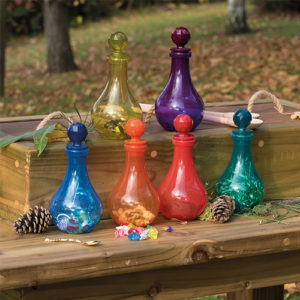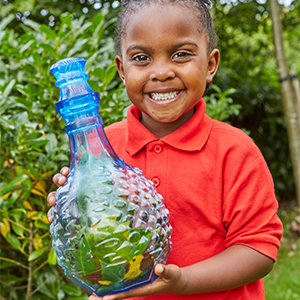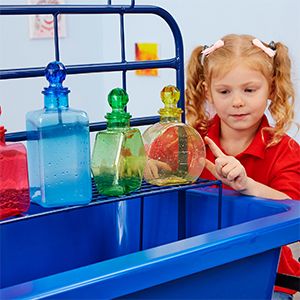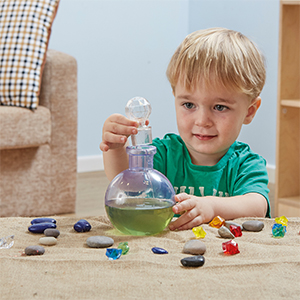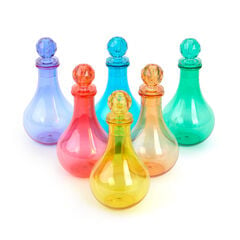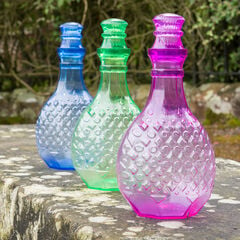We have put together a list of the most engaging potion bottle possibilities to keep little hands busy and inquisitive satisfied:
1. Set up your own home scientific laboratory
Children love to conduct experiments. To create your own laboratory, all you need is potion bottles and things you can find around the house or garden!
Space:
Provide children with a space they can get messy, either outside, in the bathroom or on a waterproof sheet with bowls.
Materials:
Children will need water to fill their potion bottles up with, but the rest you can let them find for themselves. Children might collect leaves, pebbles, flowers and bark chipping from the garden. They might also use buttons or beads from the house. What else can they use? (Safety – ensure that the size of objects do not present choking hazards to young children and objects are not sharp). You will also need Aprons or waterproofs and wellies if outdoors.
Activity:
Encourage children to experiment with adding found materials to the water filled potion bottles.
Learning opportunities:
Encourage children to watch carefully as they place different materials into the water. Spark their thinking and curiosity by asking questions such as ‘What can you see?’, ‘What is happening?’, ‘What has changed?’, ‘How does the water look different now?’ ‘Why is that one sinking?’
Children might observe:
- Materials sinking or floating
- Materials changing shape or disintegrating
- Materials changing colour
- The movement and speed of objects as they sink
Areas of learning supported
Children will be developing their scientific investigation as they begin to understand and witness sinking and floating. They will start to develop their observation skills as they watch out for and notice changes. Children’s communication skills can develop as they try to describe what they can see and why they think this might be happening. Children will be developing vital mathematical skills of shape, space and measure as they observe the changing and differing shapes of objects, compare and contrast how different objects react and notice difference in the speed of sinking objects.
2. Create your very own mud kitchen
Children love messy play. It is important to allow children the freedom to get their hands busy with messy play that sparks many senses and encourages investigation.
Space:
Preferably outdoors, where children can be free to engage in messy activity or an outdoor space which is near a hose for quick and easy cleaning.
Materials:
Mud, water, any natural materials such as leaves, flowers, small stones, bark and anything else children might find that is safe to use. Waterproofs and wellies.
Optional: old spoons, re-used plastic containers, old mashers or whisks, cupcake cases, old tins
Activity:
Encourage children to fill potion bottles up with water and add mud and other natural materials. The Giant Potion Bottles would be perfect for this activity as children can experiment with mud to water ratios more freely.
Learning opportunities:
- Experiment with quantities of water and mud- what changes can you notice?
- Children can explore consistencies of what they create- is the mixture thick? Is it runny? Is it lumpy?
- Children can make their very own mud pies- provide children with small containers for their mud pies- See optional materials.
- Children can mix, mash and scoop. This will encourage experimenting of colour changes, consistencies and developing their muscles as they move.
Areas of learning supported:
Exploration and investigation, exploring consistencies, making changes and observing these, imaginative play, physical development as children mix and mash.
3. A water station
Children love to explore water. Allowing children to do this outdoors can keep them busy for long periods of time.
Space:
A waterproof space, for example the bath or outdoors.
Materials:
Potion bottles, water, apron or waterproofs and wellies if outdoors, funnels, spoons, different sized containers
Activity:
Allow children the time and space to experiment! This seems like a very simple activity where you just step back and let the children explore. But in fact, children will be developing many skills.
Learning opportunities:
- Children can pour in and out of containers- many children enjoy this repetitive behaviour- allow them time to do this, this repetition is a way in which children start to make sense of the world around them.
- Transferring water from one container to another
- Working out how much water each container can hold – the maths measuring bottles would be perfect for this as they provide accurate measurements
- Finding ways to pour and transfer water most effectively without spillages
Areas of learning supported:
Children will be developing their hand-eye coordination as they pour from one container to another, they will be developing persistence as they try over and over again to pour water without spilling, children will be learning how to make changes after testing their ideas, they will be using their mathematical skills as they begin to notice that some containers can hold more water than others, support children in reasoning why this might be, this will be supporting their communication and language as well as mathematical reasoning surrounding shape, space and measure.
4. Colour changing experiments
Children are mesmerised by colour changes. Experiments involving colour bring out so much curiosity in children, so be prepared for many questions and excitement!
Space:
Preferably outdoors or in a space that can be easily washed, the bath can be an ideal indoor space for this activity.
Materials:
Paint or food colouring, water, apron or old clothing, preferably clear potion bottles, pencils and paper for recording. Optional: flask.
Activity:
Experiment with your child in adding paint to water. Start off with adding one colour first. Close the lid and shake the bottle. After observing and noting the changes, you can see what happens when you begin to mix the colours by adding more than one to each bottle!
Learning opportunities:
- Observing colours changes
- Recording observations and changes
- Predicting colour changes
- Experimenting with a variety of colour combinations
Areas of learning supported:
Careful observation and attention to detail as they notice changes, communication and language as children describe what they can see, model and introduce new and exciting vocabulary as you take part in describing the changes, for example, you might describe red as amber, the bluey-green colours you can see as turquoise, the musty yellows as gold etc.
Comparing and contrasting is an important mathematical skill as well as vital as a basic starting point for literacy as children need to be able to notice differences between similar letters and their sounds. Recording observations- literacy skills will be supported as children will be developing their early writing whilst they record what they can see. Support younger children in doing this.
5. Create magical, mystical potions
This final activity is definitely a favourite. It combines aspects of many of the above activities, but with extra magic, imagination and curiosity!
Space:
Preferably outdoors or in a space that can be easily washed, the bath can be an ideal indoor space for this activity.
Materials:
Water, natural materials such as leaves, flowers, petals, paint or food colouring, fresh herbs, dry spices. Apron or old clothing, preferably clear potion bottles (EY07120), pencils and paper for labelling potions. Optional: flask.
Activity:
Allow children to get imaginative with creating their very own potions. Experiment together with adding different materials such as food colouring or paint to change colours, you can also use spices and herbs for the added sensory element.
Learning opportunities:
- Spark imaginations- children can extend their imaginations by framing their potions around a story- encourage children to think about ‘What or who is the potion for?’ ‘What will happen if someone drinks (pretends to!) the potion?’
- Stimulate children’s senses by adding different spices
- Talk with children about what you can smell? What are these new smells? Name the different spices to the children and have a go at describing these together
- Think of an imaginative name for your potions- this can even be a complete new nonsense name!
- Encourage children to record their potions names on a tag and attach this to the bottle
- Maybe leave your potions to stand for a few days and see if you notice any changes as they spices might start to sink and colours begin to fade.
Areas of learning supported:
You can encourage a lot of rich language here as you make up stories together surrounding the different potions. Introduce new and exciting vocabulary to children. Imaginative language is important for children’s further literacy development- if children can talk about magical, mystical potions, then they are more likely to be able to write about these!
Literacy skills will be supported through early writing as children are encouraged to record the names of their potions. Maybe you can even try to record the ingredients too?
Children’s senses will be stimulated as they experiment with different smells and colours. Encourage children to think about ways in which they can describe new smells, new colours and the changes that they observe.
We would love to see pictures of your potion bottles, share them on social media and hashtag #takingovertts to be featured on our website.
For more learning at home ideas and inspiration click here
With thanks to Angelica Celinska for writing this blog. Angelica has 10 years of experience working in the Early Years and Primary sector with a Masters in Early Years Education from the Institute of Education, University College London (UCL).


